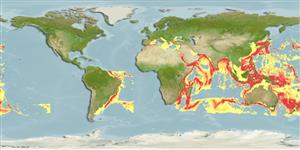Common names from other countries
Environment: milieu / climate zone / depth range / distribution range
Ecologia
; estuarina; intervalo de profundidade 0 - 4177 m (Ref. 107353). Tropical
Circumglobal.
Length at first maturity / Tamanho / Peso / Idade
Maturity: Lm ? range ? - ? cm Max length : 3.0 cm WD macho/indeterminado; (Ref. 7493)
Intertidal (Ref. 81522); Littoral to sublittoral fringe areas; known as a fouling species (Ref. 81749) - on piers, pontoons, and boat hulls (Ref. 102838). In sheltered (Ref. 125338) to exposed rocky shores. Can be found on the shells of predatory gastropods Reishia clavigera and Cellana toreuma (Ref. 127116). Part of both epibenthic and arboreal communities in mangrove areas (Ref. 128397). Sessile suspension feeder (Ref. 125928).
Life cycle and mating behavior
Maturidade | Reprodução | Desova | Ovos | Fecundidade | Larvas
Members of the superorder Thoracica are mostly hermaphroditic. Broadcast spawners, fertilization occurs in the mantle cavity. Life cycle: Eggs hatch into planktonic nauplii and leave the mantle cavity. Afterwards, they undergo six naupliar instars succeded by nonfeeding cypris larva (settling stage) which later metamorphose into adults.
Paulay, G. and A. Ross. 2003. (Ref. 7493)
Status na Lista Vermelha da IUCN (Ref. 130435)
Status no CITES (Ref. 108899)
Not Evaluated
Not Evaluated
Uso pelos humanos
| FishSource |
Ferramentas
Fontes da internet
Estimates based on models
Preferred temperature
(Ref.
115969): 2.8 - 13.7, mean 4.5 (based on 1972 cells).
Resiliência
Elevada, tempo mínimo de duplicação da população menor que 15 meses (K=0.44-0.47).
Vulnerabilidade
Low vulnerability (10 of 100).
Categoria de preço
Unknown.
